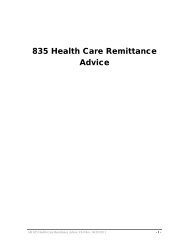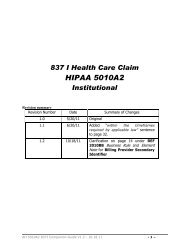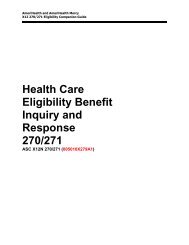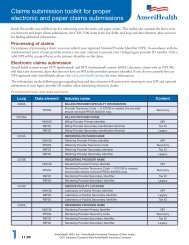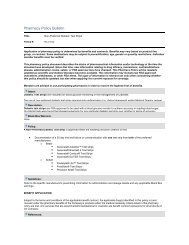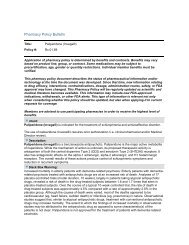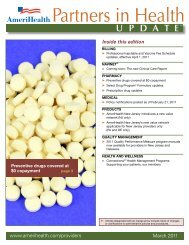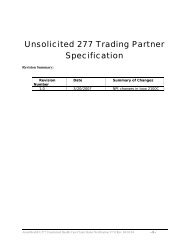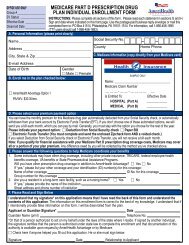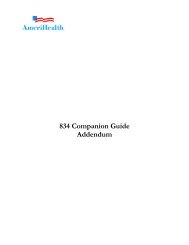Second-Generation Antipsychotic Tip Sheet - AmeriHealth.com
Second-Generation Antipsychotic Tip Sheet - AmeriHealth.com
Second-Generation Antipsychotic Tip Sheet - AmeriHealth.com
You also want an ePaper? Increase the reach of your titles
YUMPU automatically turns print PDFs into web optimized ePapers that Google loves.
<strong>Second</strong>-<strong>Generation</strong> <strong>Antipsychotic</strong> <strong>Tip</strong> <strong>Sheet</strong><br />
<strong>Second</strong>-<strong>Generation</strong> <strong>Antipsychotic</strong> Medications<br />
• Risperidone/Risperdal<br />
• Iloperidone/Fanapt<br />
• Risperidone/Risperdal<br />
• Olanzapine/Zyprexa<br />
Consta<br />
• Paliperidone/Invega/Sustenna<br />
• Asenapine/Saphris<br />
• Ziprasidone/Geodon<br />
• Clozapine/Clozaril<br />
• Aripiprazole/Abilify<br />
• Quetiapine/Seroquel<br />
• Lurasidone/Latuda<br />
Medical Issues Related to <strong>Second</strong>-<strong>Generation</strong> <strong>Antipsychotic</strong> Usage in Adults 2, 5<br />
<strong>Second</strong>-generation antipsychotics may cause abnormal blood work in adults such as:<br />
• Elevated serum glucose • Elevated serum lipid levels • Increased prolactin levels<br />
Conditions experienced may include:<br />
• Weight gain<br />
• Increased abdominal girth<br />
• Increased risk of type 2 diabetes<br />
• Diabetic ketoacidosis<br />
• Cardiovascular side effects<br />
• Sudden death in elderly<br />
Monitoring Patients on <strong>Second</strong>-<strong>Generation</strong> <strong>Antipsychotic</strong> Medications<br />
The American Diabetes Association, the American Psychiatric Association, the American Association of Clinical<br />
Endocrinologists, and the North American Association for the Study of Obesity re<strong>com</strong>mend the following screening measures for<br />
monitoring patients using second-generation antipsychotics. 1<br />
Measure Baseline 4-weeks 8-weeks 12-weeks Annually<br />
Personal/family history X X<br />
Body Mass Index (BMI) X X X X X<br />
Waist circumference X X<br />
Blood pressure X X X<br />
Fasting blood glucose X X X<br />
Fasting lipid profile X X X<br />
• There is also a need to monitor prolactin levels in patients prescribed risperidone, at baseline and follow-up intervals.<br />
• Encourage all patients on second-generation anti-psychotics to follow a healthy diet and engage in a rigorous exercise program.<br />
Both the psychiatric and medical <strong>com</strong>munities have determined that the monitoring for metabolic side effects of secondgeneration<br />
antipsychotics is an important part of patient treatment. There are however, differences in the side-effect profiles of<br />
these agents. According to The American Psychiatric Association Clinical Practice Guideline for the Treatment of Patients with<br />
Schizophrenia (2004) and its Guideline Watch (September 2009), along with other more recently published head-to-head<br />
<strong>com</strong>parison studies, clozapine and olanzapine are the most likely to lead to weight gain and glucose and lipid abnormalities.<br />
These are followed by quetiapine and then risperidone. Clinical trial data has shown that aripiprazole and ziprasidone are<br />
relatively benign. 3, 6, 7<br />
The Potential Benefits 3 of <strong>Second</strong>-<strong>Generation</strong> <strong>Antipsychotic</strong> Medications:<br />
• Prescribed for a wide variety of uses<br />
• Much reduced neurological sequelae over older agents<br />
• Much less incidence of extrapyramidal symptoms<br />
• Much less incidence of tardive dyskinesia<br />
• Increased effectiveness for some of these agents in treating the negative symptoms of schizophrenia (i.e., clozapine,<br />
olanzapine and risperidone). 8<br />
Issues Related to Use in Children<br />
In 2004, Cooper et al. reported a doubling of the use of this class of medication in children enrolled in TennCare, the state of<br />
Tennessee’s Medicaid program, for diagnoses other than schizophrenia or Tourette’s syndrome. In this study, conducted from<br />
1996 to 2001, the use of second-generation antipsychotics for ADHD, conduct disorder and affective disorders accounted for the<br />
doubled rate of use. 4 Careful consideration of the need for a second-generation antipsychotic, in addition to monitoring weight,<br />
serum glucose, lipid profile and abdominal girth in this population, is imperative in children and adolescents.<br />
©2006-2011 Magellan Health Services. This document is the proprietary information of Magellan. Rev. Rev. 11/12 12/11
<strong>Second</strong>-<strong>Generation</strong> <strong>Antipsychotic</strong> <strong>Tip</strong> <strong>Sheet</strong><br />
Summary<br />
• <strong>Second</strong>-generation antipsychotics should be used for approved indications<br />
• <strong>Second</strong>-generation antipsychotics have significant metabolic side effects<br />
• Monitoring can reduce the risk of metabolic side effects.<br />
Practitioners should base selection of antipsychotic medications on individual factors for each patient – e.g., previous response,<br />
side effect susceptibilities, family history, co-morbid conditions, medical vulnerabilities, tolerances and patient<br />
preferences/expectations. 6, 9<br />
These guidelines are not intended to replace a practitioner’s clinical judgment. They are designed to provide information and to assist<br />
practitioners with decisions regarding care. The guidelines are not intended to define a standard of care or exclusive course of<br />
treatment. Health care practitioners using these guidelines are responsible for considering their patients’ particular situations in<br />
evaluating the appropriateness of these guidelines.<br />
1. American Diabetes Association; American Psychiatric Association; American Association of Clinical Endocrinologists; North American Association for the<br />
Study of Obesity. Consensus development conference on antipsychotic drugs and obesity and diabetes. Diabetes Care 2004; 27(2):596-601.<br />
2. Straker, D. et al. Cost-effective Screening for the Metabolic Syndrome in Patients Treated with <strong>Second</strong>-<strong>Generation</strong> <strong>Antipsychotic</strong> Medications. American<br />
Journal of Psychiatry 2005; 162:1217-1221.<br />
3. American Psychiatric Association. Clinical Practice Guideline for Treating Schizophrenia 2004.<br />
4. Cooper WO, Hickson GB, Fuchs C. Archives of Pediatric and Adolescent Medicine 2004; 158: 753-759.<br />
5. Hales R, Yudofsky S. Textbook of Clinical Psychiatry 4 th edition. Arlington, Virginia, American Psychiatric Publishing, Inc., 2006.<br />
6. American Psychiatric Association. Guideline Watch (September 2009): Clinical Practice Guideline for Treating Schizophrenia.<br />
7. Leucht S, Komossa K, Rummel-Kluge C, Corves C, Hunger H, Schmid F, Lobos CA, Schwarz S, Davis JM. A Meta-Analysis of Head-to-Head Comparisons<br />
of <strong>Second</strong> <strong>Generation</strong> antipsychotics in the Treatment of Schizophrenia. Am J Psychiatry 2009: 166: 152-163.<br />
8. Leucht S, Corves C, Arbter D, Engle RR, Chunbo L, Davis JM. <strong>Second</strong>- generation versus first-generation antipsychotic drugs for schizophrenia: a metaanalysis.<br />
Lancet 2009; 373: 31-41.<br />
9. Kane JM, Correll CU. Past and Present Progress in Pharmacologic Treatment of Schizophrenia. Clin Psychiatry 71:9, September 2010.<br />
©2006-2011 Magellan Health Services. This document is the proprietary information of Magellan. Rev. Rev. 11/12 12/11





